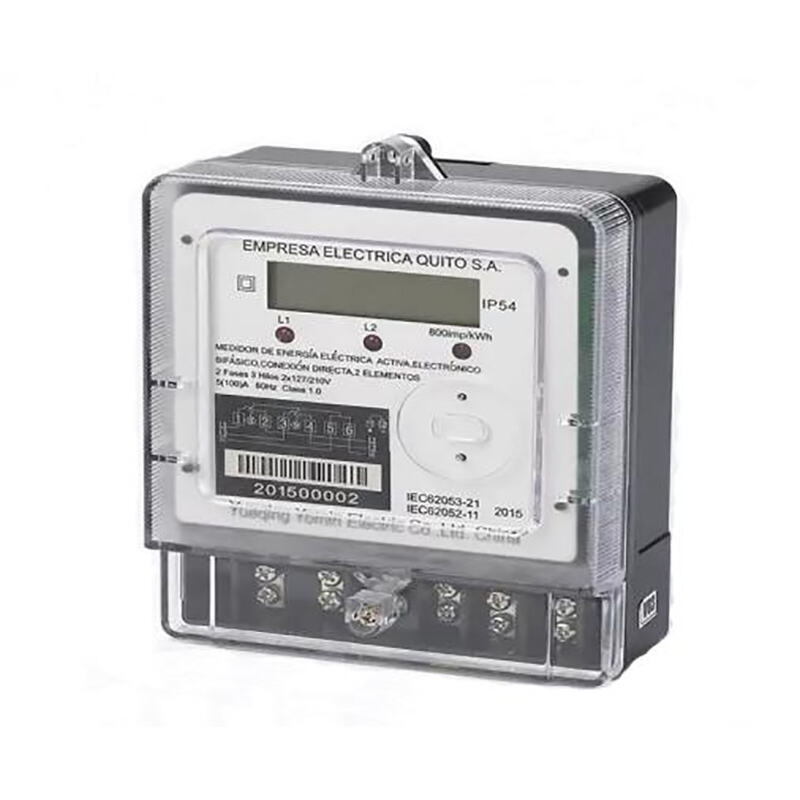عداد رقمي أحادي الطور مثبت على سكة دين عداد إلكتروني
- وصف
- المواصفات
- تفاصيل سريعة
- التطبيقات
- ميزة تنافسية
- المنتجات ذات الصلة
- استفسار
وصف
يحتوي عداد الطاقة ذو الطور الواحد والأسلاك الثنائية والمثبت على سكة دين أيضًا على مخرج نبضي مستقل عن الدائرة الداخلية. يُوصل المنفذ 21 من العداد إلى القطب الموجب، ويُوصل المنفذ 20 إلى القطب السالب. المنفذ 23 هو القطب الموجب لـ RS485، والمنفذ 24 هو القطب السالب لـ RS485. تتطلب الدائرة جهدًا قدره 5 ~ 27 فولت تيار مستمر وتيارًا أقصى قدره 27 ميلي أمبير تيار مستمر.
1.9.4 تطبيق قراءة عداد الاتصال RS485 (بروتوكول الاتصال) وعنوان المسجل
يمكن للمقاييس تسجيل البيانات عن بُعد مثل طاقة الكهرباء داخل العداد من خلال واجهة RS485 الخاصة به ونسخ بيانات طاقة الكهرباء في العداد على نطاق قريب باستخدام جهاز الكمبيوتر اليدوي عبر واجهة الاتصال بالأشعة تحت الحمراء. تنسيق الترميز، التكافؤ (التكافؤ حتى) ونمط نقل البيانات (ثمانية بتات بيانات، بت توقف واحد) تلبي متطلبات معيار MODBUS-RTU. يمكن أن يكون معدل الباود للاتصال 1200bps، 2400bps، 4800bps أو 9600bps (افتراضي). إذا لم يكن هناك أي طلب خاص، يتم ضبط العداد حسب معدل الباود الافتراضي البالغ 9600bps. يمكن تعديل عنوان العداد ومعدل الباود للاتصال باستخدام البرنامج الذي نوفره.
يستخدم العداد نوعين من المسجلات، يتم توجيههما بشكل مستقل.
النوع الأول هو مسجل البيانات، قراءة فقط، باستخدام رمز الأمر 0x04 للقراءة.
النوع الثاني هو مسجل المعلمات، الذي يمكن قراءته وكتابته، يُقرأ باستخدام رمز الأمر 0x03 ويتم ضبطه باستخدام رمز الأمر 0x10.
مثل RS-422، يمتلك RS-485 مسافة نقل قصوى تبلغ حوالي 1219 مترًا وسرعة نقل قصوى تبلغ 10 ميجابت في الثانية. طول الزوج الملتوي المتوازن عكسي النسبة مع سرعة النقل. يمكن استخدام أطول طول كابل محدد فقط عندما تكون سرعة النقل أقل من 100 كيلوبت في الثانية. أعلى معدل للنقل يكون ممكنًا فقط عند المسافات القصيرة جدًا. بشكل عام، السرعة القصوى لزوج ملتوٍ طوله 100 متر هي فقط 1 ميجابت في الثانية.
يشتمل تصميم الشبكة لـ RS-485 عادةً على بنية حافلة متصلة بالمطابقة النهائية ولا تدعم الشبكات الحلقيّة أو الشبكات النجمية. من الأفضل استخدام حافلة لربط العقد المختلفة بشكل متسلسل، ويجب أن تكون طول الخطوط الفرعية من الحافلة إلى كل عقدة قصيرًا قدر الإمكان حتى يكون للإشارة المنعكسة في الخطوط الفرعية تأثير ضئيل على إشارة الحافلة. بمعنى آخر، يجب توفير مسار إشارة مستمر ووحيد كحافلة.
يجب أن يتم توصيل درع(pair المغزلة المدرعة) إلى طرفي الدرع لكل جهاز RS-485. يُسمح بترابط الدرع بنقطة واحدة فقط.
المواصفات


تفاصيل سريعة
مطابق لمعايير RoHS خالي من الرصاص، الجهد المرجعي 230V، التيار الأساسي 5A، التيار الأقصى 80A، تردد التشغيل 50Hz±10% الاستهلاك الداخلي للطاقة ≤2W / 10VA
التطبيقات
عداد طاقة على سكة دين |
عداد طاقة مثبت على سكة دين مع بروتوكول مودبوس |
عداد طاقة مثبت على سكة دين |
عداد طاقة مثبت على سكة دين في الهند |
عداد طاقة مثبت على سكة دين من abb |
عداد طاقة ذو فase واحد لمقابس دين |
ميزة تنافسية
يستخدم العداد نوعين من المسجلات، يتم توجيههما بشكل مستقل.
النوع الأول هو مسجل البيانات، قراءة فقط، باستخدام رمز الأمر 0x04 للقراءة.
النوع الثاني هو مسجل المعلمات، الذي يمكن قراءته وكتابته، يُقرأ باستخدام رمز الأمر 0x03 ويتم ضبطه باستخدام رمز الأمر 0x10.
يمكن للمقاييس تسجيل البيانات عن بُعد مثل طاقة الكهرباء في العداد من خلال واجهة RS485 الخاصة به، ونسخ بيانات طاقة الكهرباء في العداد على مسافة قريبة باستخدام جهاز الكمبيوتر المحمول عبر واجهة الاتصال بالأشعة تحت الحمراء
 AR
AR
 EN
EN CS
CS
 DA
DA
 NL
NL
 FI
FI
 FR
FR
 DE
DE
 EL
EL
 HI
HI
 IT
IT
 JA
JA
 KO
KO
 NO
NO
 PL
PL
 PT
PT
 RO
RO
 RU
RU
 ES
ES
 SV
SV
 TL
TL
 ID
ID
 UK
UK
 VI
VI
 HU
HU
 TH
TH
 TR
TR
 FA
FA
 AF
AF
 MS
MS
 SW
SW
 UR
UR
 BN
BN
 GU
GU
 HA
HA
 KN
KN
 NE
NE
 PA
PA
 TA
TA
 TE
TE




















